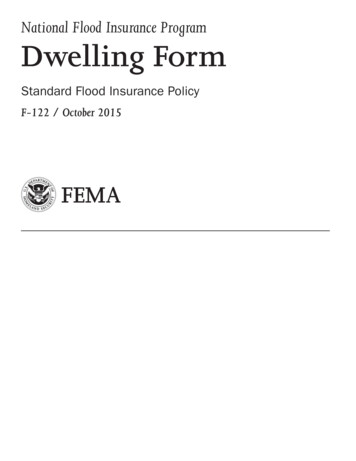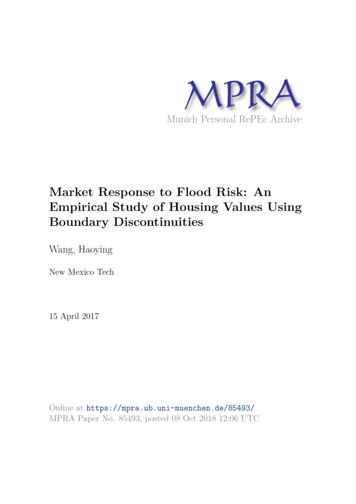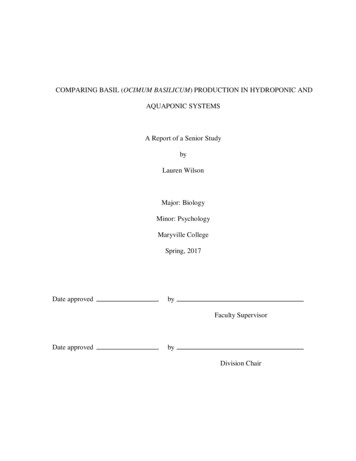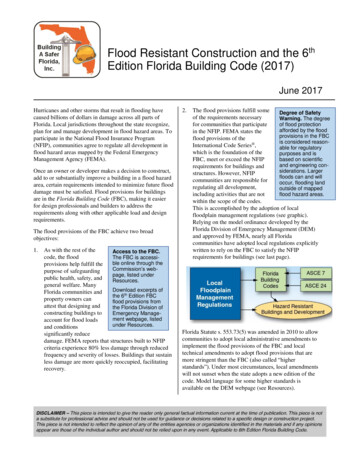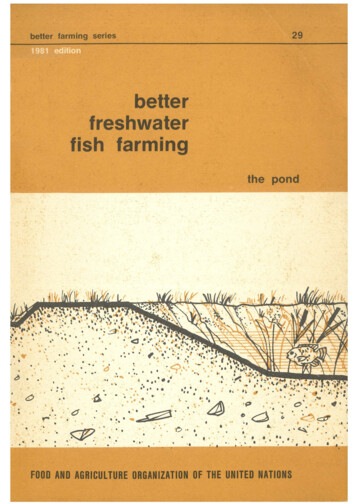
Transcription
Online ISSN : 2249 - 4626Print ISSN : 0975 - 5896Flood Effects on SoilOcimum GratissimumBrine Shrimps LethalityMeteorological ParametersVolume 12 Issue 6 Version 1.0
Global Journal of Science Frontier Research: BChemistry
Global Journal of Science Frontier Research: BChemistryVolume 12 Issue 6 (Ver. 1.0)Open Association of Research Society
Global Journal of ScienceFrontier Research .2012 .All rights reserved.Global Journals Inc.(A Delaware USA Incorporation with “Good Standing”; Reg. Number: 0423089)Sponsors: Open Association of Research SocietyOpen Scientific StandardsThis is a special issue published in version 1.0of “Global Journal of Science FrontierResearch.” By Global Journals Inc.Publisher’s Headquarters officeAll articles are open access articles distributedunder “Global Journal of Science FrontierResearch”Global Journals Inc., Headquarters Corporate Office,Cambridge Office Center, II Canal Park, Floor No.5th, Cambridge (Massachusetts), Pin: MA 02141United StatesReading License, which permits restricted use.Entire contents are copyright by of “GlobalJournal of Science Frontier Research” unlessotherwise noted on specific articles.No part of this publication may be reproducedor transmitted in any form or by any means,electronic or mechanical, includingphotocopy, recording, or any informationstorage and retrieval system, without writtenpermission.The opinions and statements made in thisbook are those of the authors concerned.Ultraculture has not verified and neitherconfirms nor denies any of the foregoing andno warranty or fitness is implied.Engage with the contents herein at your ownrisk.The use of this journal, and the terms andconditions for our providing information, isgoverned by our Disclaimer, Terms andConditions and Privacy Policy given on ourwebsite id-1463/By referring / using / reading / any type ofassociation / referencing this journal, thissignifies and you acknowledge that you haveread them and that you accept and will bebound by the terms thereof.All information, journals, this journal,activities undertaken, materials, services andour website, terms and conditions, privacypolicy, and this journal is subject to changeanytime without any prior notice.Incorporation No.: 0423089License No.: 42125/022010/1186Registration No.: 430374Import-Export Code: 1109007027Employer Identification Number (EIN):USA Tax ID: 98-0673427USA Toll Free: 001-888-839-7392USA Toll Free Fax: 001-888-839-7392Offset TypesettingOpen Association of Research Society, Marsh Road,Rainham, Essex, London RM13 8EUUnited Kingdom.Packaging & Continental DispatchingGlobal Journals, IndiaFind a correspondence nodal officer near youTo find nodal officer of your country, pleaseemail us at local@globaljournals.orgeContactsPress Inquiries: press@globaljournals.orgInvestor Inquiries: investers@globaljournals.orgTechnical Support: technology@globaljournals.orgMedia & Releases: media@globaljournals.orgPricing (Including by Air Parcel Charges):For Authors:22 USD (B/W) & 50 USD (Color)Yearly Subscription (Personal & Institutional):200 USD (B/W) & 250 USD (Color)
Editorial Board Members (HON.)John A. Hamilton,"Drew" Jr.,Ph.D., Professor, ManagementComputer Science and SoftwareEngineeringDirector, Information AssuranceLaboratoryAuburn UniversityDr. Wenying FengProfessor, Department of Computing &Information SystemsDepartment of MathematicsTrent University, Peterborough,ON Canada K9J 7B8Dr. Thomas WischgollComputer Science and Engineering,Wright State University, Dayton, OhioB.S., M.S., Ph.D.(University of Kaiserslautern)Dr. Henry HexmoorIEEE senior member since 2004Ph.D. Computer Science, University atBuffaloDepartment of Computer ScienceSouthern Illinois University at Carbondale Dr. Abdurrahman ArslanyilmazComputer Science & Information SystemsDepartmentDr. Osman Balci, ProfessorYoungstown State UniversityDepartment of Computer SciencePh.D., Texas A&M UniversityVirginia Tech, Virginia UniversityUniversity of Missouri, ColumbiaPh.D.and M.S.Syracuse University,Gazi University, TurkeySyracuse, New YorkM.S. and B.S. Bogazici University,Istanbul, TurkeyDr. Xiaohong HeYogita BajpaiM.Sc. (Computer Science), sor of International BusinessUniversity of QuinnipiacBS, Jilin Institute of Technology; MA, MS,PhD,. (University of Texas-Dallas)Dr. T. David A. ForbesAssociate Professor and RangeNutritionistPh.D. Edinburgh University - AnimalNutritionM.S. Aberdeen University - AnimalNutritionB.A. University of Dublin- ZoologyBurcin Becerik-GerberUniversity of Southern CaliforniaPh.D. in Civil EngineeringDDes from Harvard UniversityM.S. from University of California, Berkeley& Istanbul University
Dr. Bart LambrechtDirector of Research in Accounting andFinanceProfessor of FinanceLancaster University Management SchoolBA (Antwerp); MPhil, MA, PhD(Cambridge)Dr. Carlos García PontAssociate Professor of MarketingIESE Business School, University ofNavarraDoctor of Philosophy (Management),Massachusetts Institute of Technology(MIT)Master in Business Administration, IESE,University of NavarraDegree in Industrial Engineering,Universitat Politècnica de CatalunyaDr. Fotini LabropuluMathematics - Luther CollegeUniversity of ReginaPh.D., M.Sc. inMathematicsB.A. (Honors) in MathematicsUniversity of WindsoDr. Söhnke M. BartramDepartment of Accounting andFinanceLancaster University ManagementSchoolPh.D. (WHU Koblenz)MBA/BBA (University of Saarbrücken)Dr. Miguel Angel AriñoProfessor of Decision SciencesIESE Business SchoolBarcelona, Spain (Universidad de Navarra)CEIBS (China Europe International BusinessSchool).Beijing, Shanghai and ShenzhenPh.D. in MathematicsUniversity of BarcelonaBA in Mathematics (Licenciatura)University of BarcelonaPhilip G. MoscosoTechnology and Operations ManagementIESE Business School, University of NavarraPh.D in Industrial Engineering andManagement, ETH ZurichM.Sc. in Chemical Engineering, ETH ZurichDr. Lynn LimReader in Business and MarketingRoehampton University, LondonBCom, PGDip, MBA (Distinction), PhD,FHEADr. Sanjay Dixit, M.D.Director, EP Laboratories, Philadelphia VAMedical CenterCardiovascular Medicine - CardiacArrhythmiaUniv of Penn School of MedicineDr. Mihaly MezeiASSOCIATE PROFESSORDepartment of Structural and ChemicalBiology, Mount Sinai School of MedicalCenterPh.D., Etvs Lornd UniversityPostdoctoral Training,New York UniversityDr. Han-Xiang DengMD., Ph.DAssociate Professor and ResearchDepartment Division of NeuromuscularMedicineDavee Department of Neurology and ClinicalNeuroscienceNorthwestern UniversityFeinberg School of Medicine
Dr. Pina C. SanelliAssociate Professor of Public HealthWeill Cornell Medical CollegeAssociate Attending RadiologistNewYork-Presbyterian HospitalMRI, MRA, CT, and CTANeuroradiology and DiagnosticRadiologyM.D., State University of New York atBuffalo,School of Medicine andBiomedical SciencesDr. Roberto SanchezAssociate ProfessorDepartment of Structural and ChemicalBiologyMount Sinai School of MedicinePh.D., The Rockefeller UniversityDr. Wen-Yih SunProfessor of Earth and AtmosphericSciencesPurdue University DirectorNational Center for Typhoon andFlooding Research, TaiwanUniversity Chair ProfessorDepartment of Atmospheric Sciences,National Central University, Chung-Li,TaiwanUniversity Chair ProfessorInstitute of Environmental Engineering,National Chiao Tung University, Hsinchu, Taiwan.Ph.D., MS The University ofChicago, Geophysical SciencesBS National Taiwan University,Atmospheric SciencesAssociate Professor of RadiologyDr. Michael R. RudnickM.D., FACPAssociate Professor of MedicineChief, Renal Electrolyte andHypertension Division (PMC)Penn Medicine, University ofPennsylvaniaPresbyterian Medical Center,PhiladelphiaNephrology and Internal MedicineCertified by the American Board ofInternal MedicineDr. Bassey Benjamin EsuB.Sc. Marketing; MBA Marketing; Ph.DMarketingLecturer, Department of Marketing,University of CalabarTourism Consultant, Cross River StateTourism Development DepartmentCo-ordinator , Sustainable TourismInitiative, Calabar, NigeriaDr. Aziz M. Barbar, Ph.D.IEEE Senior MemberChairperson, Department of ComputerScienceAUST - American University of Science &TechnologyAlfred Naccash Avenue – Ashrafieh
President Editor (HON.)Dr. George Perry, (Neuroscientist)Dean and Professor, College of SciencesDenham Harman Research Award (American Aging Association)ISI Highly Cited Researcher, Iberoamerican Molecular Biology OrganizationAAAS Fellow, Correspondent Member of Spanish Royal Academy of SciencesUniversity of Texas at San AntonioPostdoctoral Fellow (Department of Cell Biology)Baylor College of MedicineHouston, Texas, United StatesChief Author (HON.)Dr. R.K. DixitM.Sc., Ph.D., FICCTChief Author, IndiaEmail: authorind@computerresearch.orgDean & Editor-in-Chief (HON.)Vivek Dubey(HON.)MS (Industrial Engineering),MS (Mechanical Engineering)University of Wisconsin, FICCTEditor-in-Chief, USAeditorusa@computerresearch.orgEr. Suyog Dixit(M. Tech), BE (HONS. in CSE), FICCTSAP Certified ConsultantCEO at IOSRD, GAOR & OSSTechnical Dean, Global Journals Inc. (US)Website: a DixitM.Sc., FICCTDean & Chancellor (Asia Pacific)deanind@computerresearch.orgPritesh Rajvaidya(MS) Computer Science DepartmentCalifornia State UniversityBE (Computer Science), FICCTTechnical Dean, USAEmail: pritesh@computerresearch.orgSuyash Dixit(B.E., Computer Science Engineering), FICCTTPresident, Web Administration andDevelopment , CEO at IOSRDCOO at GAOR & OSSLuis GalárragaJ!Research Project LeaderSaarbrücken, Germany
Contents of the Volumei.ii.iii.iv.v.vi.Copyright NoticeEditorial Board MembersChief Author and DeanTable of ContentsFrom the Chief Editor’s DeskResearch and Review Papers1.A Film of Polystyrene Hydroxyl end Group Supported on SiO2 Monoliths:Thermal Conductivity and Micro-Indentation. 1-9Tropospheric Ozone Concentrations and Meteorological Parameters. 11-21River Krishna Flood Effects on Soil Properties of Cultivated Areas in BagalkotDistrict, Karnataka State. 23-28The Kinetics and effect of pH on removal of Manganese, Cadmium and Leadfrom aqueous solution by maize cobs. 29-38Analytical Assessment of Cadmium, Lead and Iron in Hand Dug Wells ofIlaro, South-Western Nigeria. 39-43Ocimum Gratissimum : the Brine Shrimps Lethality of a New ChemotypeGrown in South Western Nigeria. 45-492.3.4.5.6.vii.viii.ix.x.Auxiliary MembershipsProcess of Submission of Research PaperPreferred Author GuidelinesIndex
Global Journal of Science Frontier ResearchChemistryVolume 12 Issue 6 Version 1.0 Year 2012Type : Double Blind Peer Reviewed International Research JournalPublisher: Global Journals Inc. (USA)Online ISSN: 2249-4626 & Print ISSN: 0975-5896A Film of Polystyrene Hydroxyl end Group Supported on SiO2Monoliths: Thermal Conductivity and Micro-IndentationBy O.Gutiérrez-Arriaga , S.R. Vásquez-García, N. Flores-Ramírez,G. Luna-Bárcenas, G . Barrera-Cardiel & C.A. León-PatiñoUniversity Michoacana of San Nicolas of HidalgoAbstract - Thin films (average thickness 1132, 2236, and 3785 nm) of polystyrene with ahydroxyl end group, PSOH (Mw 70345 g.mol) were supported on SiO2 monolith disks(thickness 0.2, 0.4, and 0.6 cm) to measure its thermal conductivity response using the Lee’sDisk method. The various analyses were carried out over a 40 minute period at intervals of 5minutes, at a temperature range of 20 to 110 C, as a function of PSOH film and monolith diskthickness. As a result, an extremely low thermal conductivity was determined in reference to theindividual materials. Additionally, the thermal conductivity was unaltered as a result of thevariation of the film and monolith thickness. In contrast, the hardness and ductile behavior wereincreased by increasing the thickness of the PSOH film. As a result of this, monoliths with aPSOH film of 3782 nm thicknesses (and load of 100 gf) were considered materials ofintermediate hardness (value of 31.5720 GPa). In addition, FTIR was the technique employed toestablish the PSOH and SiO2 monolith structures.Keywords : Polystyrene film, SiO2 monolith, thermal conductivity, thickness, Lee’s Disk.GJSFR-B Classification: FOR Code: 030599A Film of Polystyrene Hydroxyl end Group Supported on SiO2 MonolithsThermal Conductivity and Micro-IndentationStrictly as per the compliance and regulations of : 2012.O.Gutiérrez-Arriaga, S.R. Vásquez-García, N. Flores-Ramírez,G. Luna-Bárcenas, G . Barrera-Cardiel & C.A. León- Patiño.This is a research/review paper, distributed under the terms of the Creative Commons Attribution-Noncommercial 3.0 UnportedLicense http://creativecommons.org/licenses/by-nc/3.0/), permitting all non commercial use, distribution, and reproduction in anymedium, provided the original work is properly cited.
A Film of Polystyrene Hydroxyl end GroupSupported on SiO2 Monoliths: ThermalConductivity and Micro-Indentation3785 nm) of polystyrene with a hydroxyl end group, PSOH(Mw 70345 g.mol) were supported on SiO2 monolith disks(thickness 0.2, 0.4, and 0.6 cm) to measure its thermalconductivity response using the Lee’s Disk method. Thevarious analyses were carried out over a 40 minute period atintervals of 5 minutes, at a temperature range of 20 to 110 C,as a function of PSOH film and monolith disk thickness. As aresult, an extremely low thermal conductivity was determinedin reference to the individual materials. Additionally, thethermal conductivity was unaltered as a result of the variationof the film and monolith thickness. In contrast, the hardnessand ductile behavior were increased by increasing thethickness of the PSOH film. As a result of this, monoliths with aPSOH film of 3782 nm thicknesses (and load of 100 gf) wereconsidered materials of intermediate hardness (value of31.5720 GPa). In addition, FTIR was the technique employedto establish the PSOH and SiO2 monolith structures.Keywords : Polystyrene film, SiO2 monolith, thermalconductivity, thickness, Lee’s Disk.MI.Introductionore and more countries around the world, withpredominantly hot or cold climates, tend toexperience more extreme weather during mostof the year. In this case, the use of air conditioning,ventilation and heating systems can help maintain acomfortable temperature [1]. However, the energyconsumption is directly affected by glass windows thatare a means by which energy is gained or lost from thesurrounding environment [2]. The estimated energyconsumption by this means has generated high costs inenvironmental and economic terms [3]. This limitationcan be overcome by using a thermal insulation barrieron a conventional glass [4-6].Thin organic polymeric films are receiving moreand more attention in the field of thermal insulationAuthor α σ : Faculty of Chemical Engineering, University Michoacana ofSan Nicolas of Hidalgo, Morelia, Mich., 58030, México.E-mail : rvgarcia@umich.mxAuthor ρ : Faculty of Chemical Engineering, University Michoacana ofSan Nicolas of Hidalgo, Morelia, Mich., 58030, México.Author Ѡ : Cinvestav Querétaro, Polymer & Biopolymer ResearchGroup, Querétaro, Querétaro, 76230, México.Author § : Metallurgical Research Institute, University Michoacana ofSan Nicolas of Hidalgo, Morelia, Michoacán, 58030, México.,barriers because they present special properties, suchas transparency, light-weight, easy transportability andinstallation, and low cost. Due to this, thin organicpolymeric films have had a considerable technologicalimportance in a wide variety of fields; most of themrelated to glass coating, used as solar- protective andanti-reflection coating. In both cases, these coatingshave had a major impact on the temperature behavior[7, 8]. Equally important are the coating s physical andchemical properties, related to the adhesionphenomena, humidity and friction surface [9, 10].Polymeric thin films based on polystyrene have offeredadvantages in optical and thermal properties (noabsorption of visible light). By using this film, acousticinsulation, as well as excellent electrical and mechanicalproperties can be reached [11, 12, 13]. In addition tothis, polystyrene chains having a low-molecular weightcan improve its orientation and inter-chain dispersionwith gases, liquids, particles and polymers. This isconsidered to be particularly advantageous in thecurrent study; because with the addition of a functionalgroup as –OH, a better adhesion of polystyrene chainscan be achieved, improving its coating properties. Thishydroxyl group attracts other polar groups as hydroxyland alkoxy groups. Therefore, short-chains containing ahydroxyl end group (PSOH, Scheme 1) [14-16] providean ideal structure that can be capable of reacting withfragments that appear after the Sol-gel process.To provide evidence between PSOH andcommon glass window interaction, this common glasswas interchanged by a silicon dioxide (SiO2) substrate.This is because most commercial or common glasssubstrates have a complex chemical composition, whichcontain for the most part SiO2, alkali and alkaline earthions. They also contain the presence of impurities,making them usually unsuitable for a research protocol.In order to obtain SiO2 glasses with high purity andhomogeneity, the Sol-gel method (Scheme 1) was used[17, 18]. This process was performed at lowtemperature, allowing the researchers to obtain SiO2monolith disks (SiO2-D’s) [19]. Thus, by controlling thehydrolysis and the rate of the gel drying, transparent andlow-density SiO2-D’s were obtained [20, 21]. Thesemonoliths contain a -Si-O-Si-O- backbone and represent 2012 Global Journals Inc. (US)Year 2012Abstract - Thin films (average thickness 1132, 2236, andѠ1Global Journal of Science Frontier Research ( B ) Volume XII Issue VI Version IO.Gutiérrez-Arriaga α , S.R. Vásquez-García σ, N. Flores-Ramírez ρ, G. Luna-BárcenasG . Barrera-Cardiel & C.A. León-Patiño §
A Film of Polystyrene Hydroxyl end Group Supported on SiOMicro-IndentationYear 2012Si-OH groups, depending on the thermal treatmentused. These fragments gain importance in presence ofPSOH as result of polarity of the three functional groups.Given the context discussed above, the goal of thisstudy was to examine the possibility of using a PSOH ofmedium molecular weight to provide a thermal insulationbarrier on conventional glass windows, thus certainaspects were analyzed such as nitrogen sorptionisotherm, molecular weight, FTIR spectra, hardness(microindentation test) and thermal conductivity (usingthe Lee’s disk method).Global Journal of Science Frontier Research ( B ) Volume XII Issue VI Version I2II.Experimentala) Materials and MethodsAll reagents used in the study were purchasedfrom Sigma-Aldrich Co.: tetraethyl orthosilicate (TEOS),ethanol (ETOH), nitric acid (HNO3), toluene and 2mercaptoethanol (2-ME).Styrene was purified bytreating it with 5 wt% aqueous NaOH to remove theinhibitor and then washed with ion-free water until apH 7 was achieved. It was later dried by usinganhydrous. 2-2' Azobisisobutyronitrile (AIBN) waspurified with methanol by recrystallization.b) Synthesis of polystyrene with hydroxyl end group(PSOH)The PSOH was prepared using the followingprocedure: (1) styrene (5x10-2 moles), 2-ME (5x10-3moles) and AIBN (2.1x10-4 moles) were dissolved intoluene. (2) This mixture was degassed by severalfreeze-thaw cycles under high vacuum, and thenpolymerized for 5 hours under nitrogen gas at 70 C.2Monoliths: Thermal Conductivity andFinally, (3) the solution was diluted in toluene andprecipitated in methanol [22]. According to the reaction,the hydroxyl group -S(CH2)2OH should be present at theend of the polystyrene chain (Scheme 1).c) Silica monoliths disks (SiO2-D s)SiO2-D’s were obtained by the sol-gel process,which was completed in three stages: (1) A first solutionof TEOS/ETOH with a molar ratio of 4.5x10-3:69.0x10-3(1/4 volume relation) was heated for 15 minutes undermagnetic stirring at 60ºC [23]. (2) A second solution ofHNO3/H2O with a molar ratio of 4.7x10-3:890.0 x10-3(1.0/80 volume relation) was prepared at 18ºC. In theend, (3) both solutions were mixed and stirred for 1 hourat 60ºC. The resulting mixture was left to cool at 18ºCand then transferred to 10 ml plastic vials (drilled withsmall holes to permit a slow solvent). The plastic vialswere subsequently put under vacuum for different timeperiods during which the temperature was graduallyraised from 20 to 250ºC.d) Coating of PSOH on SiO2-DBy dipping SiO2-D (on one of its sides) partlyinto the PSOH/toluene solution once, twice or threetimes, SiO2-D s covered with PSOH were obtained.(Figure1). The dipping processes were carried out inthree replications, which were conducted at a rate of 10cm/min for 1 second, using a digital immersionapparatus.e) Instrumentation and characterization methodsThe nitrogen sorption isotherm was obtained bythe static volumetric method at 196 ºC.Escheme 1 : A) PSOH preparation using MEOH as transfer agent and B) SiO2-D matrix preparation bye the Sol-gel 2012 Global Journals Inc. (US)method.
A Film of Polystyrene Hydroxyl end Group Supported on SiOMicro-Indentation2Monoliths: Thermal Conductivity andYear 2012systems, there was a piece of copper on both sides ofthe specimen having four thermocouples A, B, C and Dwhich gave information about the interface. Each systemwas isolated with 5 firebricks forming a chamber filledwith diatomaceous earth, where a last thermocouple (E)was inserted to monitor its temperature.diameter and 2 cm along: A) uncoated and B) uncoatedwith PSOH.The specific surface area (m2/g) wasdetermined using the BET (Braunauer, Emmet andTeller) method.The molecular weights of the PSOH weremeasured using gel permeation chromatography (GPC)Waters 1525, Binary HPLC. The equipment ofuran was used as a solvent.FTIR spectra were obtained using a Tensor 27Bruker spectrometer in the 2000-400 cm-1 spectralrange, at a resolution of 4 cm-1 in absorption mode.The average film thickness was calculatedusing the polystyrene density (1.05 gcm 3 ) and it wasassumed that the film coated totally and uniformly theSiO2-D surface.The microindentation tests to determinehardness (HV) behavior were carried out using a Vickersmicroindentation tester (Durimet, Leitz, WetzlarGermany), with a 10, 25 and 100 gf load (P) in thediamond shaped indentation tip (pyramid form).Through the tester microscope, it was possibleto observe (10x) the mark on the surface of SiO2-D withand without nt through Lee’s disk method was carried outusing VirtualBench-Logger 2.5 Report NationalInstruments software, an Analog Input, NationalInstrument TC-2190 data acquisition board, 5 “k” typethermocouples with chromel and alumel joints, the hotplate, two cylindrical lead pieces (1.5 cm in diameterand 2 cm along), five firebricks (silica-alumina) anddiatomaceous earth. Figure 2 shows a schematicrepresentation of the experimental arrangement of Lee’sdisk method, where there are two systems: one thatuses pure SiO2-D and another one that uses SiO2-Dcoated with PSOH (system I and II respectively). In bothFigure 2 : Arrangement of the Lee’s disk method:System I, SiO2-D without PSOH film and System II, SiO2D with PSOH.Each experiment was carried out under stableoperating conditions for 40 minutes. While a planesurface heat source was set at a fixed temperature of110 C, the diatomaceous earth temperature was keptconstant at 20 C. It also revealed that there was no heatlost in the systems (I and II) toward the surroundings,and an appropriate isolate system was built.The equation that describes heat transferthrough conduction (Fourier Law) can be expressed asa linear approximation, as follows:(q/A)z -k(ΔT/Δz)(1)where (q/A)z is the heat flux in the z-direction inW/m2, k is the thermal conductivity in W/m K, and ΔT/Δzis the temperature gradient Tn – Tn 1; Tn Tn 1) as afunction of z-thickness (zn 1 – zn; zn 1 0 y zn 0) inºC/m. In regard to the equation describing specific heat,it can be expressed as heat transfer in transitory state:q mCP(dT/dt)(2)where q is the power in the transitory state, m isthe mass of material in g, CP is the specific heat ofmaterial in J/g ºC, and dT/dt is the differential oftemperature depending on the t-time in ºC/min. Inaddition, the cross-sectional area of a cylinder can beexpressed:(3)A πD2/4where D is the diameter of material in cm. 2012 Global Journals Inc. (US)Global Journal of Science Frontier Research ( B ) Volume XII Issue VI Version I3Figure 1 : Transparent silica monoliths of 1.5 cm in
A Film of Polystyrene Hydroxyl end Group Supported on SiOMicro-IndentationIII.Year 2012Global Journal of Science Frontier Research ( B ) Volume XII Issue VI Version IMonoliths: Thermal Conductivity andResults and Discussiona) PSOHmolecularcharacteristics42weightandmonolithThe weight-average molecular weight of PSOHwas about MW 70345 g mol-1, having a molecularweight distribution of MW/Mn 1.2. This value indicatedthat a low molecular weight PSOH was obtained.SiO2-D’s with a single diameter of 1.5 cm andthicknesses of 0.2, 0.4, and 0.6 cm were obtained, witha relative standard deviation of 3.4 and 3.0 % fordiameter and thickness respectively. These thicknesseswere used to label each SiO2-D, as SiO2-D0.2, SiO2-D0.4,and SiO2-D0.6, each one having an average weight of0.8250, 1.6498 and 2.4748 g respectively, with a relativestandard deviation of 2.5, 2.8 and 3.2 % respectively.Table 1 shows the relations between reagents andsolvents that were used in each case.Furthermore, according to the standard BETmethod, the SiO2-D’s were composed of pores having adiameter of 1.8 nm.b) FTIR analysisFigure 3 : FTIR spectra of A) PSOH having a OH groupand B) SiO2-D.Figure 3 shows the infrared absorption spectraof the PSOH and pure SiO2-D. The presence of thePSOH was determined by the characteristic bands ofpolystyrene (Figure 3A). The aromatic PSOH fractiongave a C-H stretching for the sp2 carbon at 3067 cm-1;this fraction exhibited the characteristic overtone bandsin the region from 2000-1667 cm-1 because of themonosubstituted ring. Additionally, the phenyl ringvibrations at 1601, 1452, 753 and 695 cm-1 were clearlyobserved.These peaks were assigned to the absorption ofthe longitudinal optic Si–O–Si asymmetric, Si–O–Siasymmetric stretching, Si–OH group, and Si–O–Sisymmetric stretching, respectively. Finally, throughzooming into the spectrum, a very weak broadbandsignal at 3645 cm-1, due to a O-H stretching can beeasily observed. These results conceived the existenceof an intermolecular hydrogen bonding between PSOHand SiO2-D.Table 1 : Initial concentration of the reactant for SiO2-DTable 2 shows the PSOH films thickness value(PSOHЄ) and the weight percentage (wt%) of PSOH onSiO2-D, in relation to the number of dips. The resultsshowed that all SiO2-D s coated were transparent, aswell as hard and plain in consistency.According to the experimental data (Table 2),the film thickness was independent of SiO2-D thickness,because SiO2-D s of different thicknesses absorbedalmost the same amount of PSOH after each dipping.This shows that the PSOH chains were absorbed onidentical surfaces.As a consequence, after each immersion, morechains were added (increasing the monolith weight)which suggests the existence of a strong chain-chainattraction. These new chain depositions were donewithout significant detachment (by solvation) from theprevious chains.preparationFirst solutionSecond x10-30.93303.160016.00000.298014160.2Peaks at 3278 and 2628 cm-1 were associatedwith the alkyl substituent group. Additionally, due to OH,the PSOH showed a broad stretched band centered at3465 cm-1, originated by the H .O-H bond.The spectrum presented in the Figure 3Billustrates the situation of SiO2-D. This includes intenseabsorption peaks at 1170, 1070, 950 and 800 cm-1. 2012 Global Journals Inc. (US)c) Coating of monolith by the polymer
A Film of Polystyrene Hydroxyl end Group Supported on SiOMicro-Indentation2Monoliths: Thermal Conductivity andTable 2 : PSOHЄ and gain weight percent (wt%) as function of SiO2-D thickness and numbers of dips23PSOHЄ*wt%PSOHЄ*wt%PSOH 0.02938010.074Averages113222363785* PSOH films thickness value in nm.d) Hardness determinationFigure 4 shows photos obtained after themicroindentation hardness tests.These tests determined the effect of PSOH filmthickness on SiO2-D0.2 and SiO2-D0.6.Figure 4 : Micrographs of specimens: A) pure SiO2-D0.2(100 gf), B) SiO2-D0.2 with PSOHЄ 3782 nm (100 gf), C)pure SiO2-D0.6 (10 gf), D) SiO2-D0.6 with PSOHЄ 1128nm (10 gf), and E) SiO2-D0.6 with PSOHЄ 3801nm(10 gf).The first Vickers indentation was performed onpure SiO2-D0.2, and it was made with 100 gf P. In thismonolith, a large number of cracks around the perimetermark were observed (Figure 4A).As a result of PSOH deposition, PSOHЄ 3782nm, shorter cracks and a good geometrical definition ofthe mark were determined (Figure 4B).A variant was found on the surface of the pureSiO2-D0.6 after applying a load of 10 gf P (Figure 4C).SiO2-D0.2. This situation changed when the SiO2-D0.6 wascoated with a PSOH film thickness of 1128 nm (Figure4D). In this circumstance, the cracks around theperimeter mark, as well as the geometry were betterdefined after applying the same load. Moreover, as thePSOH film thickness was increased to 3801 nm, shorterfissures around the perimeter mark and a high geometrydefinition were observed (Figure 4E).According to the above mentioned results, therewas a decrease in fissure size after the PSOH filmaddition, which was more evident as the film thicknesswas increased. This was due to the lamination effect,which is produced by the strong intermolecularinteraction between PSOH chains.Table 3 indicated that Hv values were directfunction of the geometrical mark d
University of Quinnipiac BS, Jilin Institute of Technology; MA, MS, PhD,. (University of Texas-Dallas) . MBA/BBA (University of Saarbrücken) Dr. Carlos García Pont . Master in Business Administration, IESE, University of Navarra Degree in Industrial Engineering, Universitat Politècnica de Catalunya. Dr. Miguel Angel Ariño. Professor of .

